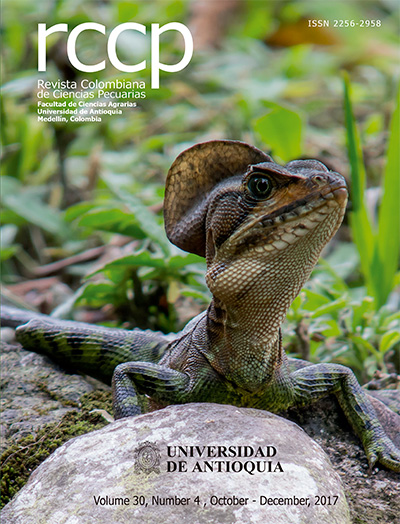Nesting materials for does: effect on nest building and performance in the first parturition
DOI:
https://doi.org/10.17533/udea.rccp.v30n4a06Keywords:
alternative material for nest, mothering ability, nesting behavior, rabbit development, rabbit growthAbstract
Background: The material placed into the nest should provide comfort to both does and their kits. Objective: To evaluate the effect of different nesting materials on rabbit doe performance and nest building. Methods: Thirty primiparous rabbit does were randomized allotted in a block design with three treatments and ten replicates each. The treatments consisted of nest bedding with wood shavings (280 g, control), Tifton hay (220 g), and thin strips of newspaper (200 g). The state of the nest was assessed to evaluate mixing of the material with doe’s hair and preservation of the original material. Kit body weight, daily weight gain, and survival rate were evaluated from birth to weaning. Results: The nesting material did not affect the mixing level of material and hair, amount of hair in the nest, body weight, daily weight gain, or survival rate of rabbits from birth to 35 d of age (p > 0.05). However, preservation of original material in the nest was lower when Tifton hay was used (p < 0.05). Correlations between material type and total number of born alive and the amount of hair, mixture level between hair and material, and material preservation in the nest were not significant (p > 0.05). No correlation (p > 0.05) was observed between material preservation and hair presence or mixture level between both. Positive correlation between hair presence and mixture level (p < 0.001) was observed. Conclusion: Tifton hay and cut newspaper can be used as nest bedding for pregnant does in replacement of wood shavings, with no negative effects on nest building behavior or kit performance.
Downloads
References
Baumann P, Oester H, Stauffacher M. Effects of temporary nest box removal on maternal behavior and pup survival in caged rabbits (Oryctolagus cuniculus). Appl Anim Behavr Sci 2005; 91:167-178.
Blumetto O, Olivas I, Torres AG, Villagrá A. Use of straw and wood shavings as nest material in primiparous does. World Rabbit Sci 2010; 18:237-242.
Canali E, Ferrante V, Todeschini R, Verga M, Carenzi C. Rabbit nest construction and its relationship with litter development. Appl Anim Behav Sci 1991; 31:259-266.
Eady SJ. Evaluation of equipment for breeding does housed under Australian meat rabbit farm conditions. Anim Prod Sci 2000; 40:717-720.
Farkas TP, Szendrö Zs, Matics Zs, Radnai I, Mayer A, Gerencsér Zs. Effect of different nest materials on performance of rabbit does. Proceedings of the 11th World Rabbit Congress 2016, 15-18 June, Qingdao, China. p. 197-200.
Garcês A, Afonso SMS, Chilundo A, Jairoce CTS. Evaluation of different litter materials for broiler production in a hot and humid environment: 1. Litter characteristics and quality. J Appl Poult Res 2013; 22:168-176.
González-Mariscal G, Caba M, Hoffman KL, Melo AI. Parental behavior. In: Pfaff DW, Joëls M (ed) Hormones, Brain and Behavior, 3rd ed., Amsterdan: Academic Press; 2016. v. 1, p. 106.
González-Mariscal G, McNitt JI, Lukefahr SD. Maternal care of rabbits in the lab and on the farm: Endocrine regulation of behavior and productivity. Horm Behav 2007; 52:86-91.
Gualterio L, Valentini A, Baglicac M. Effect of season and of parturition order on mortality rate at birth and in the nest. Proceedings of the 4th World Rabbit Congress; 1988 Oct 10-14; Budapest, Hungary. Paris: WRSA; 1988.
Hamilton HH, Lukefahr SD, McNitt JI. Maternal nest quality and its influence on litter survival and weaning performance in commercial rabbits. J Anim Sci 1997; 75:926-933.
Hudson R, Schaal B, Martínez-Gómez M, Distel H. Mother young relations in the European rabbit: Physiological and behavioural locks and keys. World Rabbit Sci 2000; 8:85-90.
Lanteigne M, Reebs SG. 2006. Preference for bedding material in Syrian hamster. Lab Anim 2006; 40:410-418.
McNitt JI, Lukefahr SD, Cheeke PR, Patton NM. Rabbit production. 9th ed., Wallingford: Cabi Publishing; 2013.
Negatu Z, McNitt JI. Hormone profiles and nest-building behavior during the periparturient period in rabbit does. Anim Reprod Sci 2002; 72:125-135.
Nowland MH, Brammer DW, Garcia A, Rush HG. Biology and diseases in rabbits. In: Fox JG, Anderson LC, Otto GM, Pritchett-Corning KR, Whary MT, editors. Laboratory Animal Medicine, 3rd ed. Amsterdan: Academic Press; 2015.
Partridge GG, Foley S, Corrigall W. Reproductive performance in purebred and crossbred commercial rabbits. Anim Prod 1981; 32:325-331.
Patry K. The rabbit-raising - problem solver. North Adams: Storey Publishing; 2014.
Rommers JM, Kemp B, Meijerhof R, Noordhuizen JPTM. Rearing management of rabbit does: A review. World Rabbit Sci 1999; 7:125-138.
Szendrö Zs, Kustos K, El-Din SS Hair pull of rabbits does and its relationship with their rearing ability. In Proceedings of the 4th World Rabbit Congress, 10-14 October 1998, Budapest, Hungary. Vol 3: 173-181.
Verga M. Intensive rabbit breeding and welfare: Development of research, trends and applications. In Proceedings of the 7th World Rabbit Congress, 4-7 July 2000, Valencia, Spain. Vol 2:491-506.
Zarrow MX, Farooq A, Denenberg VH, Sawin PB, Ross S. Maternal behavior in the rabbit: Endocrine control of maternal nest building. J Reprod Fertil 1963; 6:375-383.
Zarrow MX, Sawin PB, Ross S, Denenberg VH, Crary D, Wilson ED, Farooq A. Maternal behavior in the rabbit: Evidence for an endocrine basis of maternal nest building and additional data on maternal nest building in the Dutch belted race. J Reprod Fertil 1961; 2:152-62.
Downloads
Published
How to Cite
Issue
Section
License
Copyright (c) 2017 Revista Colombiana de Ciencias Pecuarias

This work is licensed under a Creative Commons Attribution-NonCommercial-ShareAlike 4.0 International License.
The authors enable RCCP to reprint the material published in it.
The journal allows the author(s) to hold the copyright without restrictions, and will allow the author(s) to retain publishing rights without restrictions.






